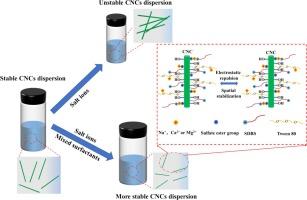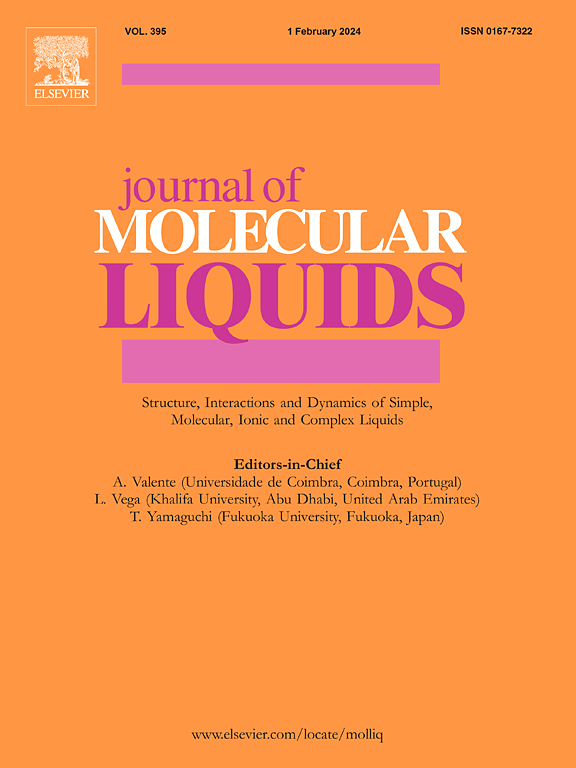表面活性剂增强纤维素纳米晶体的分散稳定性并提高采油性能
IF 5.3
2区 化学
Q2 CHEMISTRY, PHYSICAL
引用次数: 0
摘要
纤维素纳米晶体(CNCs)在 EOR 领域受到越来越多的关注。纤维素纳米晶体资源丰富且可再生,具有纳米级尺寸、优异的流变特性和易于改性的表面特性。然而,CNC 在高盐度条件下的胶体稳定性较差,限制了其在强化采油(EOR)中的应用。为了提高 CNCs 在盐环境中的稳定性,本文系统研究了十二烷基苯磺酸钠(SDBS)和聚氧乙烯山梨醇单油酸酯(Tween 80)混合体系对不同价态盐离子存在下 CNCs 分散稳定性的影响。采用ζ电位和动态光散射(DLS)技术研究了 CNCs 的分散稳定性。在所研究的盐离子浓度范围内(Na+ ≤ 300 mM、Ca2+ ≤ 10 mM、Mg2+ ≤ 10 mM),混合表面活性剂提高了 CNCs 的分散稳定性。静电效应和空间稳定效应解释了 CNC 的稳定机制。通过分子动力学(MD)模拟揭示了在盐离子存在和不存在原油的情况下,混合表面活性剂在 CNCs 表面的吸附行为。显微置换实验表明,由于 CNCs 在盐环境中的粒径较小,因此孔隙不会被堵塞,从而显著提高了石油置换性能。本文章由计算机程序翻译,如有差异,请以英文原文为准。

Surfactant-enhanced dispersion stability of cellulose nanocrystals and enhanced oil recovery performance
Cellulose nanocrystals (CNCs) have attracted more and more attention in EOR. CNCs are abundant and renewable, with nanoscale dimensions, excellent rheological properties, and easy-to-modify surface properties. However, the colloid stability of CNCs under high salinity conditions is poor, which limits their application in enhanced oil recovery (EOR). In order to improve the stability of CNCs in the salt environment, the effect of the mixed system of sodium dodecyl benzenesulfonate (SDBS) and polyoxyethylene sorbitan monooleate (Tween 80) on the dispersion stability of CNCs in the presence of different valence salt ions was investigated systematically. The dispersion stability of CNCs was investigated by using the ζ-potential and dynamic light scattering (DLS) techniques. The mixed surfactants improved the dispersion stability of CNCs within the studied salt ion concentration range (Na+ ≤ 300 mM, Ca2+ ≤ 10 mM, Mg2+ ≤ 10 mM). The stabilization mechanism of CNCs was explained by the electrostatic effect and spatial stabilization effect. In the presence of salt ions, the adsorption behavior of mixed surfactants on the surface of CNCs in the presence and absence of crude oil was revealed through molecular dynamics (MD) simulations. Microscopic displacement experiments indicated that due to the small particle size of CNCs in salt environments, the pores were not blocked, resulting in a significant improvement in the oil displacement performance.
求助全文
通过发布文献求助,成功后即可免费获取论文全文。
去求助
来源期刊

Journal of Molecular Liquids
化学-物理:原子、分子和化学物理
CiteScore
10.30
自引率
16.70%
发文量
2597
审稿时长
78 days
期刊介绍:
The journal includes papers in the following areas:
– Simple organic liquids and mixtures
– Ionic liquids
– Surfactant solutions (including micelles and vesicles) and liquid interfaces
– Colloidal solutions and nanoparticles
– Thermotropic and lyotropic liquid crystals
– Ferrofluids
– Water, aqueous solutions and other hydrogen-bonded liquids
– Lubricants, polymer solutions and melts
– Molten metals and salts
– Phase transitions and critical phenomena in liquids and confined fluids
– Self assembly in complex liquids.– Biomolecules in solution
The emphasis is on the molecular (or microscopic) understanding of particular liquids or liquid systems, especially concerning structure, dynamics and intermolecular forces. The experimental techniques used may include:
– Conventional spectroscopy (mid-IR and far-IR, Raman, NMR, etc.)
– Non-linear optics and time resolved spectroscopy (psec, fsec, asec, ISRS, etc.)
– Light scattering (Rayleigh, Brillouin, PCS, etc.)
– Dielectric relaxation
– X-ray and neutron scattering and diffraction.
Experimental studies, computer simulations (MD or MC) and analytical theory will be considered for publication; papers just reporting experimental results that do not contribute to the understanding of the fundamentals of molecular and ionic liquids will not be accepted. Only papers of a non-routine nature and advancing the field will be considered for publication.
 求助内容:
求助内容: 应助结果提醒方式:
应助结果提醒方式:


